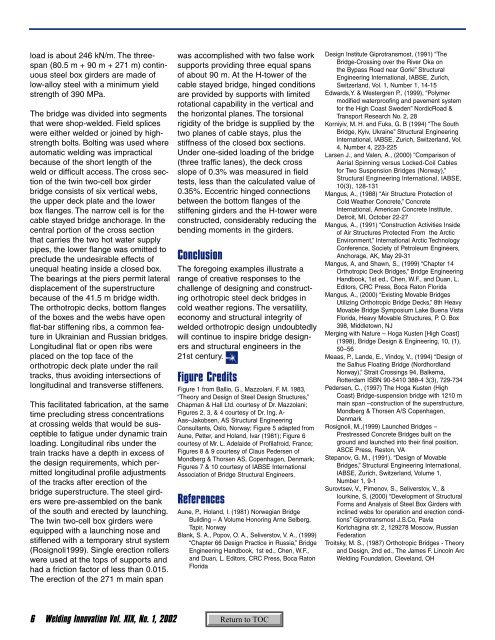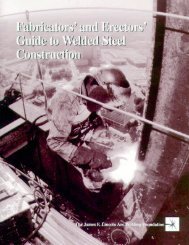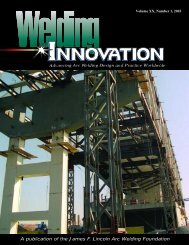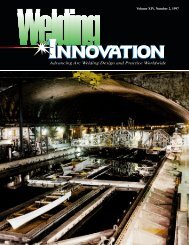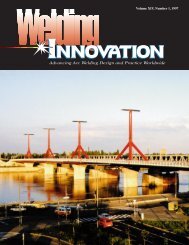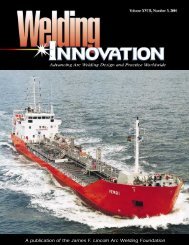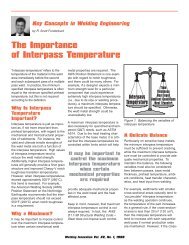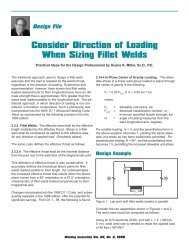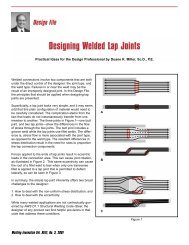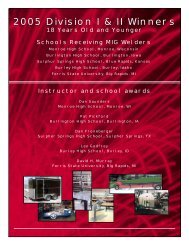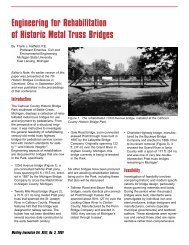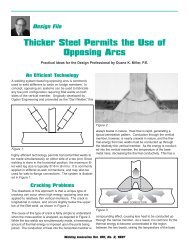A publication of the James F. Lincoln Arc Welding Foundation
A publication of the James F. Lincoln Arc Welding Foundation
A publication of the James F. Lincoln Arc Welding Foundation
Create successful ePaper yourself
Turn your PDF publications into a flip-book with our unique Google optimized e-Paper software.
load is about 246 kN/m. The threespan<br />
(80.5 m + 90 m + 271 m) continuous<br />
steel box girders are made <strong>of</strong><br />
low-alloy steel with a minimum yield<br />
strength <strong>of</strong> 390 MPa.<br />
The bridge was divided into segments<br />
that were shop-welded. Field splices<br />
were ei<strong>the</strong>r welded or joined by highstrength<br />
bolts. Bolting was used where<br />
automatic welding was impractical<br />
because <strong>of</strong> <strong>the</strong> short length <strong>of</strong> <strong>the</strong><br />
weld or difficult access. The cross section<br />
<strong>of</strong> <strong>the</strong> twin two-cell box girder<br />
bridge consists <strong>of</strong> six vertical webs,<br />
<strong>the</strong> upper deck plate and <strong>the</strong> lower<br />
box flanges. The narrow cell is for <strong>the</strong><br />
cable stayed bridge anchorage. In <strong>the</strong><br />
central portion <strong>of</strong> <strong>the</strong> cross section<br />
that carries <strong>the</strong> two hot water supply<br />
pipes, <strong>the</strong> lower flange was omitted to<br />
preclude <strong>the</strong> undesirable effects <strong>of</strong><br />
unequal heating inside a closed box.<br />
The bearings at <strong>the</strong> piers permit lateral<br />
displacement <strong>of</strong> <strong>the</strong> superstructure<br />
because <strong>of</strong> <strong>the</strong> 41.5 m bridge width.<br />
The orthotropic decks, bottom flanges<br />
<strong>of</strong> <strong>the</strong> boxes and <strong>the</strong> webs have open<br />
flat-bar stiffening ribs, a common feature<br />
in Ukrainian and Russian bridges.<br />
Longitudinal flat or open ribs were<br />
placed on <strong>the</strong> top face <strong>of</strong> <strong>the</strong><br />
orthotropic deck plate under <strong>the</strong> rail<br />
tracks, thus avoiding intersections <strong>of</strong><br />
longitudinal and transverse stiffeners.<br />
This facilitated fabrication, at <strong>the</strong> same<br />
time precluding stress concentrations<br />
at crossing welds that would be susceptible<br />
to fatigue under dynamic train<br />
loading. Longitudinal ribs under <strong>the</strong><br />
train tracks have a depth in excess <strong>of</strong><br />
<strong>the</strong> design requirements, which permitted<br />
longitudinal pr<strong>of</strong>ile adjustments<br />
<strong>of</strong> <strong>the</strong> tracks after erection <strong>of</strong> <strong>the</strong><br />
bridge superstructure. The steel girders<br />
were pre-assembled on <strong>the</strong> bank<br />
<strong>of</strong> <strong>the</strong> south and erected by launching.<br />
The twin two-cell box girders were<br />
equipped with a launching nose and<br />
stiffened with a temporary strut system<br />
(Rosignoli1999). Single erection rollers<br />
were used at <strong>the</strong> tops <strong>of</strong> supports and<br />
had a friction factor <strong>of</strong> less than 0.015.<br />
The erection <strong>of</strong> <strong>the</strong> 271 m main span<br />
was accomplished with two false work<br />
supports providing three equal spans<br />
<strong>of</strong> about 90 m. At <strong>the</strong> H-tower <strong>of</strong> <strong>the</strong><br />
cable stayed bridge, hinged conditions<br />
are provided by supports with limited<br />
rotational capability in <strong>the</strong> vertical and<br />
<strong>the</strong> horizontal planes. The torsional<br />
rigidity <strong>of</strong> <strong>the</strong> bridge is supplied by <strong>the</strong><br />
two planes <strong>of</strong> cable stays, plus <strong>the</strong><br />
stiffness <strong>of</strong> <strong>the</strong> closed box sections.<br />
Under one-sided loading <strong>of</strong> <strong>the</strong> bridge<br />
(three traffic lanes), <strong>the</strong> deck cross<br />
slope <strong>of</strong> 0.3% was measured in field<br />
tests, less than <strong>the</strong> calculated value <strong>of</strong><br />
0.35%. Eccentric hinged connections<br />
between <strong>the</strong> bottom flanges <strong>of</strong> <strong>the</strong><br />
stiffening girders and <strong>the</strong> H-tower were<br />
constructed, considerably reducing <strong>the</strong><br />
bending moments in <strong>the</strong> girders.<br />
Conclusion<br />
The foregoing examples illustrate a<br />
range <strong>of</strong> creative responses to <strong>the</strong><br />
challenge <strong>of</strong> designing and constructing<br />
orthotropic steel deck bridges in<br />
cold wea<strong>the</strong>r regions. The versatility,<br />
economy and structural integrity <strong>of</strong><br />
welded orthotropic design undoubtedly<br />
will continue to inspire bridge designers<br />
and structural engineers in <strong>the</strong><br />
21st century.<br />
Figure Credits<br />
Figure 1 from Ballio, G., Mazzolani, F. M. 1983,<br />
“Theory and Design <strong>of</strong> Steel Design Structures,”<br />
Chapman & Hall Ltd. courtesy <strong>of</strong> Dr. Mazzolani;<br />
Figures 2, 3, & 4 courtesy <strong>of</strong> Dr. Ing. A-<br />
Aas–Jakobsen, AS Structural Engineering<br />
Consultants, Oslo, Norway; Figure 5 adapted from<br />
Aune, Petter, and Holand, Ivar (1981); Figure 6<br />
courtesy <strong>of</strong> Mr. L. Adelaide <strong>of</strong> Pr<strong>of</strong>ilafroid, France;<br />
Figures 8 & 9 courtesy <strong>of</strong> Claus Pedersen <strong>of</strong><br />
Mondberg & Thorsen AS, Copenhagen, Denmark;<br />
Figures 7 & 10 courtesy <strong>of</strong> IABSE International<br />
Association <strong>of</strong> Bridge Structural Engineers.<br />
References<br />
Aune, P., Holand, I. (1981) Norwegian Bridge<br />
Building – A Volume Honoring Arne Selberg,<br />
Tapir, Norway<br />
Blank, S. A., Popov, O. A., Seliverstov, V. A., (1999)<br />
“Chapter 66 Design Practice in Russia,” Bridge<br />
Engineering Handbook, 1st ed., Chen, W.F.,<br />
and Duan, L. Editors, CRC Press, Boca Raton<br />
Florida<br />
Design Institute Giprotransmost, (1991) “The<br />
Bridge-Crossing over <strong>the</strong> River Oka on<br />
<strong>the</strong> Bypass Road near Gorki” Structural<br />
Engineering International, IABSE, Zurich,<br />
Switzerland, Vol. 1, Number 1, 14-15<br />
Edwards,Y. & Westergren P., (1999), “Polymer<br />
modified waterpro<strong>of</strong>ing and pavement system<br />
for <strong>the</strong> High Coast Sweden” NordicRoad &<br />
Transport Research No. 2, 28<br />
Korniyiv, M. H. and Fuks, G. B (1994) “The South<br />
Bridge, Kyiv, Ukraine” Structural Engineering<br />
International, IABSE, Zurich, Switzerland, Vol.<br />
4, Number 4, 223-225<br />
Larsen J., and Valen, A., (2000) “Comparison <strong>of</strong><br />
Aerial Spinning versus Locked-Coil Cables<br />
for Two Suspension Bridges (Norway),”<br />
Structural Engineering International, IABSE,<br />
10(3), 128-131<br />
Mangus, A., (1988) “Air Structure Protection <strong>of</strong><br />
Cold Wea<strong>the</strong>r Concrete,” Concrete<br />
International, American Concrete Institute,<br />
Detroit, MI, October 22-27<br />
Mangus, A., (1991) “Construction Activities Inside<br />
<strong>of</strong> Air Structures Protected From <strong>the</strong> <strong>Arc</strong>tic<br />
Environment,” International <strong>Arc</strong>tic Technology<br />
Conference, Society <strong>of</strong> Petroleum Engineers,<br />
Anchorage, AK, May 29-31<br />
Mangus, A, and Shawn, S., (1999) “Chapter 14<br />
Orthotropic Deck Bridges,” Bridge Engineering<br />
Handbook, 1st ed., Chen, W.F., and Duan, L.<br />
Editors, CRC Press, Boca Raton Florida<br />
Mangus, A., (2000) “Existing Movable Bridges<br />
Utilizing Orthotropic Bridge Decks,” 8th Heavy<br />
Movable Bridge Symposium Lake Buena Vista<br />
Florida, Heavy Movable Structures, P. O. Box<br />
398, Middletown, NJ<br />
Merging with Nature – Hoga Kusten [High Coast]<br />
(1998), Bridge Design & Engineering, 10, (1),<br />
50–56<br />
Meaas, P., Lande, E., Vindoy, V., (1994) “Design <strong>of</strong><br />
<strong>the</strong> Salhus Floating Bridge (Nordhordland<br />
Norway),” Strait Crossings 94, Balkema,<br />
Rotterdam ISBN 90-5410 388-4 3(3), 729-734<br />
Pedersen, C., (1997) The Hoga Kusten (High<br />
Coast) Bridge-suspension bridge with 1210 m<br />
main span –construction <strong>of</strong> <strong>the</strong> superstructure,<br />
Mondberg & Thorsen A/S Copenhagen,<br />
Denmark<br />
Rosignoli, M.,(1999) Launched Bridges –<br />
Prestressed Concrete Bridges built on <strong>the</strong><br />
ground and launched into <strong>the</strong>ir final position,<br />
ASCE Press, Reston, VA<br />
Stepanov, G. M., (1991), “Design <strong>of</strong> Movable<br />
Bridges,” Structural Engineering International,<br />
IABSE, Zurich, Switzerland, Volume 1,<br />
Number 1, 9-1<br />
Surovtsev, V., Pimenov, S., Seliverstov, V., &<br />
Iourkine, S, (2000) “Development <strong>of</strong> Structural<br />
Forms and Analysis <strong>of</strong> Steel Box Girders with<br />
inclined webs for operation and erection conditions”<br />
Giprotransmost J.S.Co, Pavla<br />
Kortchagina str. 2, 129278 Moscow, Russian<br />
Federation<br />
Troitsky, M. S., (1987) Orthotropic Bridges - Theory<br />
and Design, 2nd ed., The <strong>James</strong> F. <strong>Lincoln</strong> <strong>Arc</strong><br />
<strong>Welding</strong> <strong>Foundation</strong>, Cleveland, OH<br />
6 <strong>Welding</strong> Innovation Vol. XIX, No. 1, 2002


